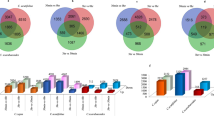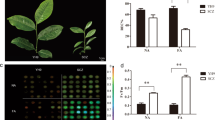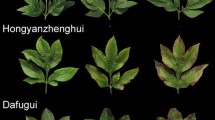Abstract
Main conclusion
The molecular mechanisms regulating calcium-mediated thermotolerance in Camellia sinensis were revealed by RNA-Sequencing.
Heat stress is one of the most remarkable abiotic factors limiting the growth and productivity of Camellia sinensis plants. Calcium helps regulate plant responses to various adverse environmental conditions, including heat stress. In this study, the effects of exogenous calcium on the physiological characteristics of heat-stressed C. sinensis were investigated. A calcium pretreatment increased the proline, soluble sugar, Ca2+, and chlorophyll contents, but decreased the malondialdehyde content and relative electrical conductivity in C. sinensis leaves under heat stress. Further analysis of the ultra-structure of chloroplasts indicated that heat stress induced accumulation of starch granules and destruction of the stroma lamella in C. sinensis. However, calcium pretreatment counteracted the adverse effects of heat stress on the structure of the photosynthetic apparatus. These results imply that the calcium pretreatment increased C. sinensis thermotolerance. Moreover, RNA-sequencing was applied to characterize the calcium-mediated transcript-level responses to heat stress. A total of 923 differentially expressed genes (DEGs) including 299 up-regulated and 624 down-regulated genes were identified. Functional annotations indicated that these DEGs were primarily related to signal transduction, transcriptional regulation, and post-translational modification. In addition, a C. sinensis gene [CsCML45 (GenBank: KY652927)] encoding a calmodulin-like protein was isolated. The heterologous expression of CsCML45 enhanced the thermotolerance of transgenic Arabidopsis thaliana plants. These results may be useful for characterizing the calcium-mediated molecular mechanism responsible for C. sinensis thermotolerance.






Similar content being viewed by others
Abbreviations
- CDPK:
-
Calcium-dependent protein kinase
- CML:
-
Calmodulin-like protein
- COG:
-
Clusters of Orthologous Groups
- DEG:
-
Differentially expressed gene
- ERF:
-
Ethylene-responsive factor
- GO:
-
Gene Ontology
- HSP:
-
Heat-shock protein
- KEGG:
-
Kyoto Encyclopedia of Genes and Genomes
- KOG:
-
euKaryotic Orthologous Groups
- MDA:
-
Malondialdehyde
- Nr:
-
Non-redundant protein
References
Anders S, Huber W (2010) Differential expression analysis for sequence count data. Genome Biol 11:R106
Apweiler R, Bairoch A, Wu CH, Barker WC, Boeckmann B, Ferro S, Gasteiger E, Huang HZ, Lopez R, Magrane M, Martin MJ, Natale DA, O’Donovan C, Redaschi N, Yeh LSL (2004) UniProt: the universal protein knowledgebase. Nucleic Acids Res 32:D115–D119
Ashburner M, Ball CA, Blake JA, Botstein D, Butler H, Cherry JM, Davis AP, Dolinski K, Dwight SS, Eppig JT, Harris MA, Hill DP, Issel-Tarver L, Kasarskis A, Lewis S, Matese JC, Richardson JE, Ringwald M, Rubin GM, Sherlock G, Consortium GO (2000) Gene ontology: tool for the unification of biology. Nat Genet 25:25–29
Bates LS, Waldren RP, Teare ID (1973) Rapid determination of free proline for water-stress studies. Plant Soil 39:205–207
Bita CE, Gerats T (2013) Plant tolerance to high temperature in a changing environment: scientific fundamentals and production of heat stress-tolerant crops. Front Plant Sci 4:273
Buysse J, Merckx R (1993) An improved colorimetric method to quantify sugar content of plant tissue. J Exp Bot 44:1627–1629
Catola S, Marino G, Emiliani G, Huseynova T, Musayev M, Akparov Z, Maserti BE (2016) Physiological and metabolomic analysis of Punica granatum (L.) under drought stress. Planta 243:441–449
Cui J, Jiang N, Zhou XX, Hou XX, Yang GL, Meng J, Luan YS (2018) Tomato MYB49 enhances resistance to Phytophthora infestans and tolerance to water deficit and salt stress. Planta. https://doi.org/10.1007/s00425-018-2987-6
Das A, Das S, Mondal TK (2012) Identification of differentially expressed gene profiles in young roots of tea [Camellia sinensis (L.) O. Kuntze] subjected to drought stress using suppression subtractive hybridization. Plant Mol Biol Rep 30:1088–1101
Deng Y, Li J, Wu S, Zhu Y, Chen Y, He F (2006) Integrated nr database in protein annotation system and its localization. Comput En 32:71–74 (in Chinese with English abstract)
Draper HH, Hadley M (1990) Malondialdehyde determination as index of lipid-peroxidation. Methods Enzymol 186:421–431
Feng YZ, Zhang L, Fu JM, Li FD, Wang L, Tan XF, Mo WJ, Cao HP (2016) Characterization of glycolytic pathway genes using RNA-Seq in developing kernels of Eucommia ulmoides. J Agric Food Chem 64:3712–3731
Finn RD, Bateman A, Clements J, Coggill P, Eberhardt RY, Eddy SR, Heger A, Hetherington K, Holm L, Mistry J, Sonnhammer ELL, Tate J, Punta M (2014) Pfam: the protein families database. Nucleic Acids Res 42:D222–D230
Gong M, Li YJ, Dai X, Tian M, Li ZG (1997) Involvement of calcium and calmodulin in the acquisition of heat-shock induced thermotolerance in maize seedlings. J Plant Physiol 150:615–621
Grabherr MG, Haas BJ, Yassour M, Levin JZ, Thompson DA, Amit I, Adiconis X, Fan L, Raychowdhury R, Zeng QD, Chen ZH, Mauceli E, Hacohen N, Gnirke A, Rhind N, di Palma F, Birren BW, Nusbaum C, Lindblad-Toh K, Friedman N, Regev A (2011) Full-length transcriptome assembly from RNA-Seq data without a reference genome. Nat Biotechnol 29:644–652
Hashimoto K, Kudla J (2011) Calcium decoding mechanisms in plants. Biochimie 93(12):2054–2059
Huang YT, Qian WJ, Wang B, Cao HL, Wang L, Hao XY, Wang XC, Yang YJ (2015) Effects of exogenous calcium and inhibitors of calcium signaling transduction pathway on cold resistance of tea plant. J Tea Sci 35:520–526 (in Chinese with English abstract)
Kanehisa M, Goto S, Kawashima S, Okuno Y, Hattori M (2004) The KEGG resource for deciphering the genome. Nucleic Acids Res 32:D277–D280
Kishor PBK, Sangam S, Amrutha RN, Laxmi PS, Naidu KR, Rao KRSS, Rao S, Reddy KJ, Theriappan P, Sreenivasulu N (2005) Regulation of proline biosynthesis, degradation, uptake and transport in higher plants: its implications in plant growth and abiotic stress tolerance. Curr Sci 88:424–438
Koonin EV, Fedorova ND, Jackson JD, Jacobs AR, Krylov DM, Makarova KS, Mazumder R, Mekhedov SL, Nikolskaya AN, Rao BS, Rogozin IB, Smirnov S, Sorokin AV, Sverdlov AV, Vasudevan S, Wolf YI, Yin JJ, Natale DA (2004) A comprehensive evolutionary classification of proteins encoded in complete eukaryotic genomes. Genome Biol 5:R7
Kotak S, Larkindale J, Lee U, von Koskull-Doring P, Vierling E, Scharf KD (2007) Complexity of the heat stress response in plants. Curr Opin Plant Biol 10:310–316
Larkindale J, Knight MR (2002) Protection against heat stress-induced oxidative damage in Arabidopsis involves calcium, abscisic acid, ethylene, and salicylic acid. Plant Physiol 128:682–695
Li YF, Wang YX, Tang YH, Kakani VG, Mahalingam R (2013) Transcriptome analysis of heat stress response in switchgrass (Panicum virgatum L.). BMC Plant Biol 13:153
Liu SC, Yao MZ, Ma CL, Jin JQ, Ma JQ, Li CF, Chen L (2015) Physiological changes and differential gene expression of tea plant under dehydration and rehydration conditions. Sci Hortic 184:129–141
Liu SC, Jin JQ, Ma JQ, Yao MZ, Ma CL, Li CF, Ding ZT, Chen L (2016a) Transcriptomic analysis of tea plant responding to drought stress and recovery. PLoS One 11:e0147306
Liu ZW, Wu ZJ, Li XH, Huang Y, Li H, Wang YX, Zhuang J (2016b) Identification, classification, and expression profiles of heat shock transcription factors in tea plant (Camellia sinensis) under temperature stress. Gene 576:52–59
Livak KJ, Schmittgen TD (2001) Analysis of relative gene expression data using real-time quantitative PCR and the 2−ΔΔCT method. Methods 25:402–408
McCormack E, Tsai YC, Braam J (2005) Handling calcium signaling: Arabidopsis CaMs and CMLs. Trends Plant Sci 10:383–389
Miao YY, Zhu ZB, Guo QS, Zhu YH, Yang XH, Sun Y (2016) Transcriptome analysis of differentially expressed genes provides insight into stolon formation in Tulipa edulis. Front Plant Sci 7:409
Ohama N, Sato H, Shinozaki K, Yamaguchi-Shinozaki K (2017) Transcriptional regulatory network of plant heat stress response. Trends Plant Sci 22:53–65
Perochon A, Aldon D, Galaud JP, Ranty B (2011) Calmodulin and calmodulin-like proteins in plant calcium signaling. Biochimie 93:2048–2053
Ray S, Agarwal P, Arora R, Kapoor S, Tyagi AK (2007) Expression analysis of calcium-dependent protein kinase gene family during reproductive development and abiotic stress conditions in rice (Oryza sativa L. ssp indica). Mol Genet Genom 278:493–505
Ren LP, Sun J, Chen SM, Gao JJ, Dong B, Liu YN, Xia XL, Wang YJ, Liao Y, Teng NJ, Fang WM, Guan ZY, Chen FD, Jiang JF (2014) A transcriptomic analysis of Chrysanthemum nankingense provides insights into the basis of low temperature tolerance. BMC Genom 15:844
Ruibal C, Castro A, Carballo V, Szabados L, Vidal S (2013) Recovery from heat, salt and osmotic stress in Physcomitrella patens requires a functional small heat shock protein PpHsp16.4. BMC Plant Biol 13:174
Sami F, Yusuf M, Faizan M, Faraz A, Hayat S (2016) Role of sugars under abiotic stress. Plant Physiol Biochem 109:54–61
Song AP, Zhu XR, Chen FD, Gao HS, Jiang JF, Chen SM (2014) A chrysanthemum heat shock protein confers tolerance to abiotic stress. Int J Mol Sci 15:5063–5078
Sun BM, Zhu ZS, Cao PR, Chen H, Chen CM, Zhou X, Mao YH, Lei JJ, Jiang YP, Meng W, Wang YX, Liu SQ (2016a) Purple foliage coloration in tea (Camellia sinensis L.) arises from activation of the R2R3-MYB transcription factor CsAN1. Sci Rep 6:32534
Sun XB, Sun CY, Li ZG, Hu Q, Han LB, Luo H (2016b) AsHSP17, a creeping bentgrass small heat shock protein modulates plant photosynthesis and ABA-dependent and independent signalling to attenuate plant response to abiotic stress. Plant Cell Environ 39:1320–1337
Szabados L, Savoure A (2010) Proline: a multifunctional amino acid. Trends Plant Sci 15:89–97
Tan W, Meng QW, Brestic M, Olsovska K, Yang XH (2011) Photosynthesis is improved by exogenous calcium in heat-stressed tobacco plants. J Plant Physiol 168:2063–2071
Tatusov RL, Galperin MY, Natale DA, Koonin EV (2000) The COG database: a tool for genome-scale analysis of protein functions and evolution. Nucleic Acids Res 28:33–36
Trapnell C, Williams BA, Pertea G, Mortazavi A, Kwan G, van Baren MJ, Salzberg SL, Wold BJ, Pachter L (2010) Transcript assembly and quantification by RNA-Seq reveals unannotated transcripts and isoform switching during cell differentiation. Nat Biotechnol 28:511–515
Upadhyaya H, Panda SK, Dutta BK (2011) CaCl2 improves post-drought recovery potential in Camellia sinensis (L.) O. Kuntze. Plant Cell Rep 30:495–503
Wahid A, Gelani S, Ashraf M, Foolad MR (2007) Heat tolerance in plants: an overview. Environ Exp Bot 61:199–223
Wang CT, Song W (2014) ZmCK3, a maize calcium-dependent protein kinase gene, endows tolerance to drought and heat stresses in transgenic Arabidopsis. J Plant Biochem Biol 23:249–256
Wang WX, Vinocur B, Shoseyov O, Altman A (2004) Role of plant heat-shock proteins and molecular chaperones in the abiotic stress response. Trends Plant Sci 9:244–252
Wang Y, Yu QY, Tang XX, Wang LL (2009a) Calcium pretreatment increases thermotolerance of Laminaria japonica sporophytes. Prog Nat Sci 19:435–442
Wang Z, Gerstein M, Snyder M (2009b) RNA-Seq: a revolutionary tool for transcriptomics. Nat Rev Genet 10:57–63
Wang XC, Zhao QY, Ma CL, Zhang ZH, Cao HL, Kong YM, Yue C, Hao XY, Chen L, Ma JQ, Jin JQ, Li X, Yang YJ (2013) Global transcriptome profiles of Camellia sinensis during cold acclimation. BMC Genom 14:415
Wang WD, Wang YH, Du YL, Zhao Z, Zhu XJ, Jiang X, Shu ZF, Yin Y, Li XH (2014) Overexpression of Camellia sinensis H1 histone gene confers abiotic stress tolerance in transgenic tobacco. Plant Cell Rep 33:1829–1841
Wang L, Wang YC, Cao HL, Hao XY, Zeng JM, Yang YJ, Wang XC (2016) Transcriptome analysis of an anthracnose-resistant tea plant cultivar reveals genes associated with resistance to Colletotrichum camelliae. PLoS One 11:e0148535
Wu ZJ, Li XH, Liu ZW, Xu ZS, Zhuang J (2014) De novo assembly and transcriptome characterization: novel insights into catechins biosynthesis in Camellia sinensis. BMC Plant Biol 14:277
Wu ZJ, Li XH, Liu ZW, Li H, Wang YX, Zhuang J (2015) Transcriptome-based discovery of AP2/ERF transcription factors related to temperature stress in tea plant (Camellia sinensis). Funct Integr Genom 15:741–752
Wu QJ, Chen ZD, Sun WJ, Deng TT, Chen MJ (2016a) De novo sequencing of the leaf transcriptome reveals complex light-responsive regulatory networks in Camellia sinensis cv. Baijiguan. Front Plant Sci 7:332
Wu ZJ, Tian C, Jiang Q, Li XH, Zhuang J (2016b) Selection of suitable reference genes for qRT-PCR normalization during leaf development and hormonal stimuli in tea plant (Camellia sinensis). Sci Rep 6:19748
Zhang XR, Henriques R, Lin SS, Niu QW, Chua NH (2006) Agrobacterium-mediated transformation of Arabidopsis thaliana using the floral dip method. Nat Protoc 1:641–646
Acknowledgements
This research was supported by the National Natural Science Foundation of China (31470690), the earmarked fund for Modern Agro-industry Technology Research System (CARS-19), the Priority Academic Program Development of Jiangsu Higher Education Institutions (PAPD), the Fundamental Research Funds for the Central Universities (2662017QD036), and the Natural Science Foundation of Hubei Province (2018CFB134).
Author information
Authors and Affiliations
Corresponding author
Electronic supplementary material
Below is the link to the electronic supplementary material.
Rights and permissions
About this article
Cite this article
Wang, M., Zhang, X., Li, Q. et al. Comparative transcriptome analysis to elucidate the enhanced thermotolerance of tea plants (Camellia sinensis) treated with exogenous calcium. Planta 249, 775–786 (2019). https://doi.org/10.1007/s00425-018-3039-y
Received:
Accepted:
Published:
Issue Date:
DOI: https://doi.org/10.1007/s00425-018-3039-y




